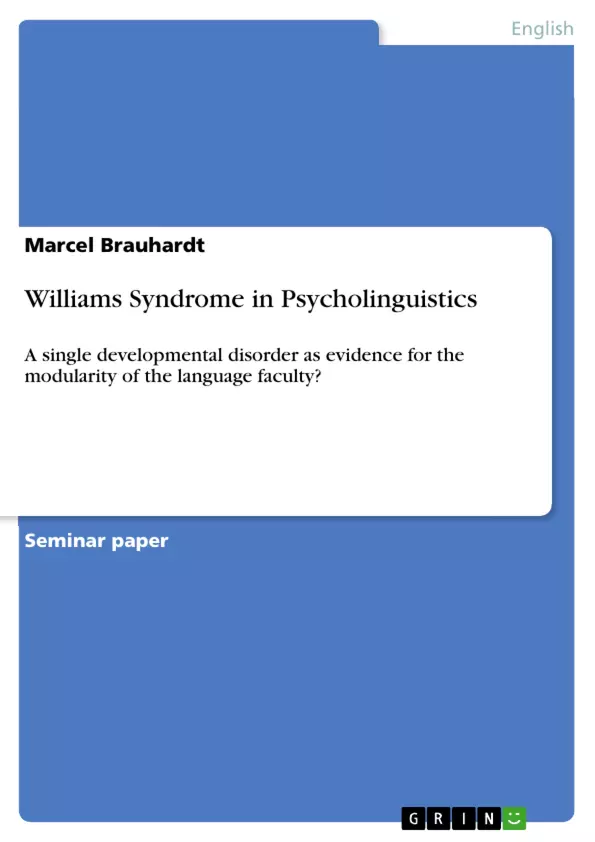Background:
In their study, Clahsen and Almazan (2001) tried to show that the analysis of Williams syndrome from a linguistic perspective might lead to evidence for the modular structure of the human language faculty, a widespread assumption yet, but without accepted evidence. Karmiloff-Smith amongst others, argues by contrast that disorders, such as Williams syndrome, are too complex to allow such general deduction as presented by Clahsen and Almazan.
Method:
First, the study by Clahsen and Almazan is going to be introduced. Then, more recent and challenging argumentation from different sources will be discussed in terms of plausibility of the conclusion drawn by the authors of the study.
Result:
The explanation offered by Clahsen and Almazan is clearly nondevelopmental and therefore discounts vital aspects of language acquisition, especially for people with disorders. Thus, their core argument turns out to be hardly tenable.
Conclusion:
Evaluation of the contrasting argumentation shows that neither Williams syndrome nor other disorders such as Specific language impairment alone can serve as ultimate proof for modularity of the human language faculty. Disorders rather point to crucial developmental delays and disadvantages in the process of language acquisition and therefore cannot be evidence for the dual structure of the language faculty. Even within single domains, fractionation occurs at such a complex level that any explanation must consider the aspect of development.
Inhaltsverzeichnis (Table of Contents)
- Preface
- Subject
- The Neurocognitive Profile of Williams Syndrome
- Williams Syndrome - A Neurodevelopmental Disorder as Evidence for the dual Structure of the Human Language Faculty
- The Study by Clahsen and Almazan
- Origin
- Subjects and Experiments
- On the Linguistic Background
- Conclusion
- The Study by Clahsen and Almazan
- The Alternative Perspective
- The Aspect of Development
- Development and the Deep Level of Fractionation in WMS
- Evaluation
- The Aspect of Development
Zielsetzung und Themenschwerpunkte (Objectives and Key Themes)
The work investigates the potential of Williams syndrome (WMS) as evidence for the modular structure of the human language faculty, a widely accepted assumption lacking concrete evidence. The study by Clahsen and Almazan argues for this connection, but this work challenges their conclusions by emphasizing the developmental aspects of the disorder, which Clahsen and Almazan largely dismiss. The work argues that the complexity of WMS and other developmental disorders renders them insufficient for proving modularity in the language faculty.
- Modularity of the Language Faculty
- Williams Syndrome as Evidence for Modularity
- Developmental Aspects of Williams Syndrome
- Fractionation in Williams Syndrome
- The Role of Development in Language Acquisition
Zusammenfassung der Kapitel (Chapter Summaries)
- Preface: This chapter introduces the debate surrounding the modular structure of the human language faculty and focuses on Williams syndrome as a potential source of evidence. It highlights the ongoing research on language impairments like Williams syndrome and Specific language impairment (SLI), particularly the complexities of comparing these disorders. The chapter also points to the challenge of considering the developmental aspects of these disorders in their connection to language acquisition. The introduction concludes by outlining the structure of the work, emphasizing the importance of development in understanding the linguistic profile of WMS.
- The Neurocognitive Profile of Williams Syndrome: This chapter outlines the unique cognitive profile of Williams syndrome, characterized by a stark contrast between strong language abilities and lower overall IQ. It highlights the discrepancies between spatial and face processing, and explores the implications of this uneven cognitive landscape for understanding language development in individuals with WMS. The chapter emphasizes the hypersocial nature of people with WMS, their strong social interaction skills, and the potential for language skills to mask underlying difficulties in language acquisition.
- Williams Syndrome - A Neurodevelopmental Disorder as Evidence for the dual Structure of the Human Language Faculty: This chapter introduces the study by Clahsen and Almazan, which presents Williams syndrome as evidence for the modular structure of the language faculty. It examines the study's methods, focusing on the subjects, experiments, and linguistic background of the research. The chapter concludes by presenting the study's findings and highlighting its shortcomings in terms of accounting for developmental aspects of the disorder.
Schlüsselwörter (Keywords)
Williams Syndrome, Specific language impairment (SLI), language acquisition, modularity, language faculty, neurocognitive profile, developmental disorder, fractionation, cognitive domains, social interaction, language processing.
- Quote paper
- Marcel Brauhardt (Author), 2010, Williams Syndrome in Psycholinguistics, Munich, GRIN Verlag, https://www.grin.com/document/152299



